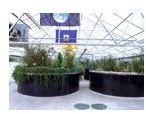Wastewater Treatment: The Eco Machine™ and its Biomimicry Methods
What is an Eco Machine™?
This machine is not just a simple wastewater treatment apparatus but an ecological concept of biomimicry to purify water the natural way. An Eco Machine™ may come as a tank based treatment system or a wastewater system integrated inside a greenhouse. The sewage water is treated through a series of tanks containing artificially constructed wetland or marsh made out of sand and gravel. Instead of using chemicals as cleaning agent, aquatic living creatures comprised of aquatic creatures like snails and small fishes as well as different species of plants and vegetations. The artificially constructed ecosystem takes charge of cleaning the water in different stages.
Biomimicry is a way of providing sustainable wastewater solutions by imitating the ecological system of diverse living creatures in transforming waste materials into nutrients, to sustain a habitat.
How Does the Machine Work?
Each of the machine’s treatment tank or greenhouse, is integrated with a full-bodied ecosystem represented by different groups of living organisms from microscopic algae, bacteria, fungi, zooplankton to snails, fishes and clams. The machine’s greenhouse has shrubs and trees grown in suspended fiberglass racks.
The overall design is that of a river with conflicting flow of water swirls and counter currents and a “contact zone” or particular point where the diverse ecological life system will interact and/or interlock according to their relationship with each other. The entire wastewater treatment process is patterned or mimics the water purification processes that take place in wetlands and marshes.
It is capable of producing quality recycled water without using toxic chemicals in its wastewater treatment process. By using ecological engineering principles, the biomimicry method to process wastewater is totally devoid of chemical substances in order to reuse or recycle wastewater. Recycled water becomes suitable water supply for toilets, irrigation and other non-potent water usage.
The passage in the last tank has a seepage filter akin to those installed in septic tanks. Said filter will prevent the accidental release of undesirable solids, mostly plant debris which can mar the supposedly high quality appearance of recycled water.
De-nitrification processes will also take place to remove the nitrogen polishing component in anoxic zones or areas that are completely devoid of oxygen. Some plants and microorganisms will absorb unwanted nitrogen and phosphorus to support the de-nitrification processes of the machine’s sustainable system.
An Example of the Machine’s Contribution to the Environment
New England Biolabs in Boston- Prior to the granting of permit for this facility to operate, the state of Massachusetts required that the wastes from this lab’s enzyme production be treated before releasing them as runoffs into the nearby wetlands.
Hence, as the lab’s compliance to this stringent condition, an this ecological machine was installed. The existing ecosystem found here is in a greenhouse maintained at 80°F throughout the year. Wastewater initially enters a 16,600 gallon blending tank and thereafter proceeds to the treatment-train containing four open tanks. At the top of the tanks are floating racks that hold about 8 to 9 species of plants with varying nutrients. Wastewater will stay here for about half of the day.
After passing through these four tanks the wastewater will proceed to a clarifier which can hold an estimated 6,000 gallons. This is where the sand filter and constructed wetland grown with tropical plants like cana lilies and banana trees will take out the bacteria and rubbles in a span of 3 hours. The last stage will be a UV disinfection procedure before the treated wastewater is released into a leach field and later on to nearby wetlands.
As a sustainable attribute, bananas are said to be harvested from the greenhouse even during winter seasons. Other waste water recycling systems of this machine, are greenhouses supporting vegetations.
Who Invented The Eco Machine™ ?
This wastewater treatment machine was invented by Dr. John Todd, an internationally known inventor and pioneer of biomimicry method in wastewater recycling process. Many of his wastewater constructions have also been implemented in 11 countries across the globe and are haled as the “green solution to the growing global wastewater crisis”.
Photo courtesy of www.toddecological.com
